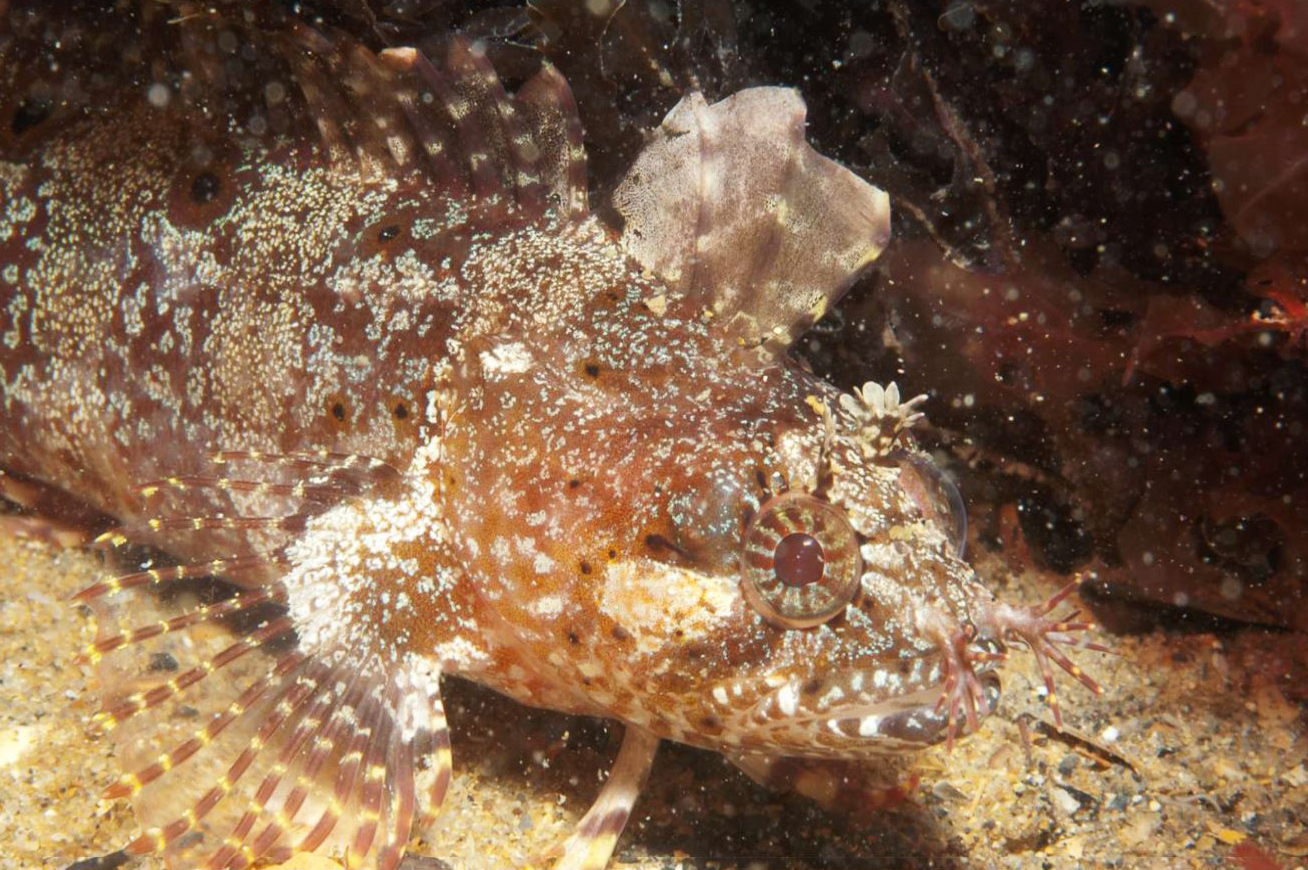Johnston's Weedfish, Heteroclinus johnstoni (Saville-Kent 1886)
Other Names: Johnstons Weedfish

Johnston's Weedfish, Heteroclinus johnstoni, at Portsea, Port Phillip, Victoria, 2005. Source: Julian K. Finn / Museum Victoria. License: CC by Attribution
Summary:
A mottled brown to reddish weedfish with large lobed nasal tentacles, irregular bars on the body extending onto the dorsal and anal fins and each enclosing a large black spot (each surrounded by yellow to yellowish-brown ring) along the back, and a whitish patch extending from the eye onto the cheek. Each orbital tentacle is broad with 4-8 elongate to irregular uneven lobes. The nasal tentacles are large with 6-7 slender, elongate lobes in a semicircle around each anterior nostril.
Cite this page as:
Bray, D.J. 2024, Heteroclinus johnstoni in Fishes of Australia, accessed 01 Jul 2025, https://fishesofaustralia.net.au/Home/species/3
Johnston's Weedfish, Heteroclinus johnstoni (Saville-Kent 1886)
More Info
|
Distribution |
Wilsons Promontory, Victoria, to Ceduna, South Australia, including around Tasmania. Inhabits low rocky reefs in sandy areas, usually sheltering amongst macroalgae. |
|
Features |
Dorsal fin III + XXXI-XXXIV, 5-6; Anal fin II, 25-27; Caudal fin (segmented rays) 10-12: Pectoral fin 14-16; Pelvic fin I, 3: Lateral line scales 20-29 (arched portion); Gill rakers 1-2 + 7-9 = 9-11. Body of moderate size (depth at anal fin origin 18-25% SL), strongly compressed; caudal peduncle very slender. Head of moderate to large size (25-31% SL); eyes of moderate size (5-8% SL); mouth large (upper jaw length 12-16% SL), reaching to below posterior edge of eyes and sometimes beyond; 41-51 circumorbital head pores arranged biserially; each orbital tentacle broad, with four to eight elongate to irregularly shaped, uneven lobes (3-6% SL); nasal tentacles large with six or seven slender, elongate lobes in semicircle around each anterior nostril; gill rakers simple. Scales on body cycloid; lateral line scales extending to caudal peduncle, anterior scales overlapping each with single posterior pore positioned either dorsally, medially, or ventrally, posterior scales not overlapping, each with single median pore at either end; anterior lateral line scales with a single pore, either ventrally, dorsally or medially. Two dorsal fins, first dorsal slightly elevated (second spine 8-11% SL), originating over posterior preopercular margins; first dorsal connected by membrane to basal part of second dorsal; flaps extending posteriorly from dorsal spines bound in fin membrane; anal fin membrane deeply incised; basal quarter of last anal ray attached by membrane to caudal peduncle; caudal fin rounded (15-20% SL). Pectoral fins large, rounded. Pelvic fins jugular, rays stout, not reaching to anus, inner ray one half to two thirds length of second ray. |
|
Size |
The largest clinid species found on Australia, reaching 40 cm TL. |
|
Colour |
Head and body reddish to brown, mottled with white and yellow; about eight broken, vertical bars on body extending onto dorsal and anal fins; seven large black spots surrounded by ring of yellow along dorsolateral surface of body, similar spot at anterior end of lateral line and one above each pectoral fin base; head with randomly scattered, moderate sized black spots; whitish oblong patch radiating posteriorly from lower posterior half of each eye; fins brownish with yellow bands and lines. |
|
Remarks |
Johnston's Weedfish is commonly taken on hook and line in Tasmania. |
|
Etymology |
The species is named in honour of Robert Mackenzie Johnston: "I have proposed to distinguish this hitherto undescribed fish by the name of Clinus Johnstoni, the specific title being associated with that of Mr. R. M. Johnston, F.L.S., author of a Descriptive Catalogue of the Fishes of Tasmania, and to whom science is much indebted for the already advanced position of our knowledge of the fish fauna of this Colony." |
|
Species Citation |
Clinus johnstoni Saville Kent 1886, Rep. Fish. Dept. Tasm. 1886: 13. Type locality: Adventure Bay, Tasmania. |
|
Author |
Bray, D.J. 2024 |
|
Resources |
Johnston's Weedfish, Heteroclinus johnstoni (Saville-Kent 1886)
References
Coleman, N. 1980. Australian Sea Fishes South of 30ºS. Lane Cove, NSW : Doubleday Australia Pty Ltd 309 pp.
Edgar, G.J. 2008. Australian Marine Life: the plants and animals of temperate waters. Sydney : Reed New Holland 2nd edn, 624 pp.
Edgar, G.J., Last, P.R. & Wells, M.W. 1982. Coastal Fishes of Tasmania and Bass Strait. Hobart : Cat & Fiddle Press 175 pp.
Hoese, D.F., Gomon, M.F. & Rennis, D.S. 2008. Family Clinidae. pp. 696-722 in Gomon, M.F., Bray, D.J. & Kuiter, R.H. (eds) Fishes of Australia's Southern Coast. Sydney : Reed New Holland 928 pp.
Hutchins, J.B. & Swainston, R. 1986. Sea Fishes of Southern Australia. Complete field guide for anglers and divers. Perth : Swainston Publishing 180 pp.
Kuiter, R.H. 1993. Coastal Fishes of South-eastern Australia. Bathurst : Crawford House Press 437 pp.
Kuiter, R.H. 1996. Guide to Sea Fishes of Australia. A comprehensive reference for divers and fishermen. Sydney, NSW, Australia : New Holland Publishers xvii, 434 pp.
Last, P.R., Scott, E.O.G. & Talbot, F.H. 1983. Fishes of Tasmania. Hobart : Tasmanian Fisheries Development Authority 563 pp. figs.
Rennis, D., Hoese, D.F. & Gomon, M.F. 1994. Family Clinidae. pp. 741-775, figs 650-684B in Gomon, M.F., Glover, C.J.M. & Kuiter, R.H. (eds) The Fishes of Australia's South Coast. Adelaide : State Printer 992 pp. 810 figs.
Saville-Kent, W. 1886. New or rare fish taken in Tasmanian waters. Report. Fisheries Department Tasmania 1886: 13-14 PDF
Saville-Kent, W. 1886. Observations on a suspected hybrid species of trumpeter, and upon other rare fish taken in Tasmanian waters. Papers and Proceedings of the Royal Society of Tasmania 1886: 117-124. See ref online
Scott, T.D., Glover, C.J.M. & Southcott, R.V. 1974. The Marine and Freshwater Fishes of South Australia. Adelaide : Government Printer 392 pp. figs. (as Petraites johnstoni)
Williams, J.T., Holleman, W. & Clements, K.D. 2014. Heteroclinus johnstoni. The IUCN Red List of Threatened Species 2014: e.T178945A1551130. http://dx.doi.org/10.2305/IUCN.UK.2014-3.RLTS.T178945A1551130.en. Downloaded on 17 August 2016.







